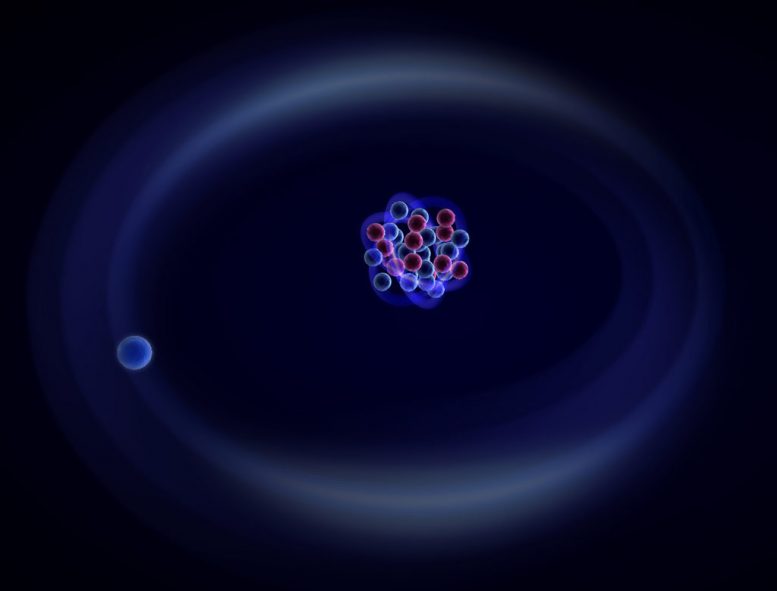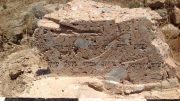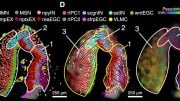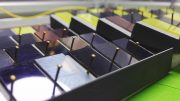
Neutron-rich magnesium nuclei have a neutron halo that extends beyond the tightly packed core of the nucleus. Credit: 2014 Ken-ichiro Yoneda, RIKEN Nishina Center for Accelerator-Based Science
Using the RIKEN Radioactive Isotope Beam Factory, physicists have revealed that the extra neutrons in a neutron-rich magnesium nucleus produce a neutron halo.
Most stable atomic nuclei are made up of roughly an equal number of protons and neutrons. With the right equipment, however, physicists can create nuclei with many additional neutrons. These neutron-rich nuclei are short-lived but represent an important tool for developing a better understanding of how the elements in the Universe were created.
A collaborative study led by Nobuyuki Kobayashi and Takashi Nakamura from the Tokyo Institute of Technology involving researchers from the RIKEN Nishina Center for Accelerator-Based Science has now revealed that the extra neutrons in a neutron-rich magnesium nucleus produce a neutron halo1.
The researchers used RIKEN’s Radioactive Isotope Beam Factory to produce nuclei of magnesium-37, consisting of 25 neutrons and 12 protons. To examine its properties, the researchers observed what happened when these nuclei were bombarded against a lead target. “We found that the magnesium-37 nuclei broke up easily into a magnesium-36 core and a single neutron,” says Kobayashi. “Thus, we concluded that magnesium-37 has a neutron halo.”
Neutron halos are dilute cloud of neutrons that surround the more tightly packed neutrons and protons found at the center of a nucleus. They have been identified in the past, but predominantly in nuclei with fewer than 20 neutrons. Magnesium-37 is so far the heaviest nuclei to have been found to have a nuclear halo. Evidence of a halo-like structure also implies that magnesium-37 nuclei are deformed and do not conform to the conventional spherical shape.
The researchers then performed a similar experiment using a carbon target. Whereas the lead-target experiments revealed the reaction of the nuclei to electrostatic forces, the use of a carbon target made it possible to study the response of magnesium-37 to nuclear forces, which are sensitive to the rotational motion of the neutrons. The halo neutrons found in previously studied light nuclei, in which the core is surrounded by a single neutron, have no rotation and are known as s-wave halos. In contrast, Kobayashi and his colleagues found that the halo neutron in magnesium-37 had a measurable angular momentum or rotation, called a p-wave halo.
The results provide a vital insight into why some nuclei are stable while others decay. “Our results indicate that the formation of halos may be a universal feature in neutron-rich nuclei,” explains Ken-ichiro Yoneda, one of the RIKEN researchers who contributed to the project. “The reason why they exist, however, is still unclear. We hope to accumulate more detailed information about other neutron-rich nuclei so that we can better understand the halo-formation mechanism.”
Reference: “Observation of a p-wave one-neutron halo configuration in 37Mg” by N. Kobayashi, T. Nakamura, Y. Kondo, J. A. Tostevin, Y. Utsuno, N. Aoi, H. Baba, R. Barthelemy, M. A. Famiano, N. Fukuda, N. Inabe, M. Ishihara, R. Kanungo, S. Kim, T. Kubo, G. S. Lee, H. S. Lee, M. Matsushita, T. Motobayashi, T. Ohnishi, N. A. Orr, H. Otsu, T. Otsuka, T. Sako, H. Sakurai, Y. Satou, T. Sumikama, H. Takeda, S. Takeuchi, R. Tanaka, Y. Togano and K. Yoneda, 18 March 2014, Physical Review Letters.
DOI: 10.1103/PhysRevLett.112.24250









Be the first to comment on "Physicists Reveal a Neutron Halo Around Neutron-Rich Magnesium Nuclei"